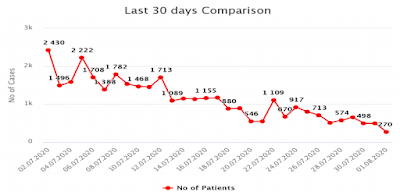By Mukhtar Alam
(Pakistan News & Features Services)
As the nation celebrates Eid-ul-Azha with traditional enthusiasm, fingers remained cross as far as the outcome was concerned regarding spread of coronavirus (COVID-19) in the country. It’s being hoped that SOPs will not be ignored this time unlike a couple of months ago which had resulted in spike following Eid-ul-Fitr.
Sindh, having endured a July with higher number of COVID-19 fatalities, reported three deaths on August 1 when the authorities confirmed 270 new patients during the last 24 hours across the province, with an overall infection rate of 16%.
In all 7,676 samples were tested during the last 24 hours ending August 1 afternoon, with a positivity rate of 3.5%. Sindh, during the month of July, had reported an average 27 COVID-19 deaths daily.
The Sindh Chief Minister, Syed Murad Ali Shah, in his daily COVID-19 statement, shared that overall 121,309 positive cases were found among 767,712 samples from across the province since February 26 when Sindh reported its first infection at Karachi.
According to the statement, issued by his secretariat on August 1, as many as 8,164 patients were receiving treatment in the province, including 7,593 those at homes, 559 at hospitals, out of which 369 were told critically ill while 64 patients were put on ventilators.
In the meantime, an official report revealed that of the 11 patients who died on July 31 included two who died at homes. As many as nine patients lost their lives in Karachi, while another one each at Hyderabad and Mirpurkhas.
According to data, as of July 31, about 15 of the designated COVID-19 testing laboratories in Sindh did not conduct any test during the last 24 hours.
In all 107 (40%) new positive cases were reported from Karachi, followed by Hyderabad (25), Sukkur (16), Ghotki (12), Dadu (9), Shaheed Benazirabad (9), Jamshoro (8), Naushero Feroze (8), Jacobabad (8), Sanghar (7), Khairpur (7), Shikarpur (7), Mirpurkhas (5), Sujawal (5), Umerkot (5), Larkana (4), Kambar Shahdadkot (3), Badin (2) and Thatta (2).
The testing at majority of the laboratories is expected to be on the lower side due to the Eid-ul-Azha holidays.




